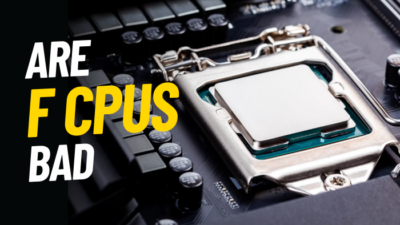Tech geeks are never shy of experimenting with crazy things and running CPUs without heatsink is one of them. But the thing is, will it be a healthy experiment or is there a possibility of damaging your CPU?
Don’t put a stop to your thoughts there. In this article, I will try to dig out all your questions and answer them and explain every fact behind them.
As a hardware maintenance Engineer, I am solving hardware-related problems for more than 10 years. I will guide you through every point that you need to know.
Try to read the entire article to clear all your doubts. I have explained everything in this article.
Is it Safe to Run a CPU without a Heatsink or Cooler?
No, it’s not safe to run a CPU without a heatsink. Don’t even try this; it may damage your CPU by frying up the transistors. CPU generates massive heat while performing too many applications running concurrently. Heat dissipation is a must for the CPU.
Sometimes it generates enough heat to melt down the transistors and other components. But modern CPU will automatically turn itself down when the temperature will rise above 80-100°C. This happens to protect the CPU from damage.
Therefore, running a CPU without a heatsink or starting a PC without a CPU cooler, heat will spread throughout the entire component and the temperature will rise.
If you run your CPU without the heatsink you may see smoke coming out of your CPU, which is enough to get the cold sweat out of you. If you want to run a CPU without a heatsink then it’s a big NO for you.
So, What is basically a heatsink?
A heatsink is mainly a metal component that is made out of aluminum or copper. Heatsink mainly seats on the top of the CPU or other components which generate heat and it has risen fins from which it draws out the heat from the components.
To dissipates heat, it has to make strong contact with the electronic component and between them, there is a thermal conductor to pass the heat quickly into the fins. This heatsink works like a radiator. It doesn’t have any moving parts.
But as the CPU generates massive heat it needs a fan in its heatsink to blow the hot air away. CPU heatsink also contains copper pipes in them for better heat dissipation as copper is an excellent heat conductor.
What Causes CPUs to Overheat?
When electricity passes through a component like a transistor or a conductor it will generate heat. As you know CPU is the main processing unit of an entire system. It performs millions of operations like executing instructions, input and output operations, processing of binary data, etc.
While processing this data and executing tons of operations within a fraction of seconds, it needs to pass billions of electric signals throughout its transistors. As you know modern CPU has billions of transistors. If electricity passes through these billions of transistors within a tiny space it will generate a massive amount of heat.
There are other complex types of electronic components available in the CPU. If you are doing normal tasks like creating a doc file or simply browsing then it shouldn’t be heating that much, it will heat up so much when you start gaming, rendering videos, or performing other multi-task-related work.
So, the processor will generate an excessive amount of heat when it has to perform tons of calculations. This overheating can cause the CPU to lag or even shut down the computer completely. To maintain this heat at an ideal temperature, you have to use a heatsink.
How to Check your CPU Temperature
It is mandatory to check your CPU temperature for better stable performance. CPU is the core component of your entire system. As it handles tons of calculations and processes binary data, it generates a lot of heat during this time.
You can easily check CPU temperature using BIOS or third-party apps. Also, the MSI Afterburner program lets you monitor CPU temperature.
Overheating can cause throttling, which can slow down your entire system by affecting the clock speed of the CPU. If your CPU keeps overheating all the time then it will reduce the life span of your CPU, which is bad news for you.
So, to keep the system stable and throttle free you should keep an eye on the CPU temperature. To do this many third-party software are available. Softwares like Core Temp, Open Hardware Monitor, and CPUID HWMonitor can show you core temp with minimum and maximum temp.
You can also go to the BIOS settings to check your CPU and motherboard temperature by going to the hardware monitor option. Motherboard manufacturer company also provides utility software to check the entire system stability where you can check CPU and motherboard temperature. Which is a great method the check the temperature.
What are the Alternatives to the Heatsink?
There are many alternatives to choose from to cool down your CPU. You can find many products with pro-grade hardware and specs to run your CPU at an idle temperature while your CPU is under a high workload.
Here are the alternatives to the heatsink that you can use:
- Air CPU Cooler: Air CPU cooler is quite popular now these days. Its heatsink base and fins are made out of aluminum and there are several heat pipes that are made of copper. These heat pipes and heatsink help to absorb the heat directly from the CPU.This air cooler comes with one or two attached fans which help to blow the hot air out of the fins and pipes. Thermal paste between the air cooler and CPU helps to absolve the heat quickly.
- AIO Liquid Cooler: This cooler is now dominating the CPU cooler market. It has a copper heatsink base with a built-in pump with the heatsink which controls the water flow from the radiator. The radiator is connected with the pump through pipes. Fans are attached to the radiator to help the hot temperature blow away.
- Custom Liquid Cooler: Custom liquid coolers are also available but these are costly. It consists of components like water blocks, reservoirs, tubes, pumps, fittings, tubes, radiators, and fans. Water blocks are prebuilt with heatsinks which help to dissipate the heat from the CPU. The custom water cooler is the best option for cooling the CPU.
How to Maintain a Lower CPU Temperature
To maintain a lower CPU temperature you have to keep your entire system clean. Dust can be a silent killer by blocking the airways which can raise the temperature. You have to set the air intake fan and exhaust correctly so that air can pass sufficiently throughout the case.
Try to check the thermal paste condition to fix the CPU over-temperature error. If it is necessary to change then change it without any hesitation. A stock cooler is sometimes not sufficient enough to cool down the CPU. Try to change it and upgrade to an air cooler or AIO liquid cooler.
FAQs
How long can you run your CPU without a Heatsink?
Your CPU will run not more than 5 to 10 seconds without the heatsink. Don’t try to run your CPU without a heatsink on it. It will cause serious damage to the CPU.
Maximum temperature limit for the CPU?
The maximum temperature limit for the CPU is between 80 to 100 degrees celsius. If the temperature exceeds this limit then it will shut down itself automatically to avoid damage.
What is the idle temperature for the CPU?
The idle temperature for the CPU is between 30 to 40 degrees celsius. Sometimes it is based on room temperature. Try to run your system at 25 to 30 degrees Celsius room temperature.
Conclusion
So, try to run your CPU always with the Heatsink on it if you don’t want to destroy it. It’s always better to run your CPU at idle temperature because it gives you a more stable performance. Running your CPU at a high temperature constantly may damage its lifespan and cause damage to the transistors. Try to use an air cooler or liquid cooler.
I think this article helps you to clear all your doubts If you have gone through the entire article. Please let me know through comments if you face any difficulties understanding any above topics.




